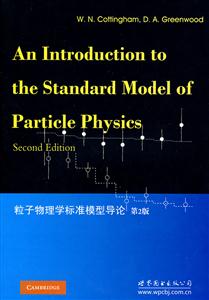中圖網小程序
一鍵登錄
更方便
本類五星書更多>
-
>
宇宙、量子和人類心靈
-
>
氣候文明史
-
>
南極100天
-
>
考研數學專題練1200題
-
>
希格斯:“上帝粒子”的發明與發現
-
>
神農架疊層石:10多億年前遠古海洋微生物建造的大堡礁
-
>
聲音簡史
粒子物理學標準模型導論-第2版 版權信息
- ISBN:9787510005541
- 條形碼:9787510005541 ; 978-7-5100-0554-1
- 裝幀:一般膠版紙
- 冊數:暫無
- 重量:暫無
- 所屬分類:>>
粒子物理學標準模型導論-第2版 本書特色
《粒子物理學標準模型導論(第2版)》由世界圖書出版公司出版。
粒子物理學標準模型導論-第2版 內容簡介
本書從介子和夸克的電磁作用和弱相互作用開始,講到了夸克的強相互作用,內容層層深入。介紹標準模型的同時,作者非常注重選材的可進階性,方便讀者更深入的研讀。
粒子物理學標準模型導論-第2版 目錄
preface to the second edition
preface to the first edition
notation
1 the particle physicist's view of nature
1.1 introduction
1.2 the construction of the standard model
1.3 leptons
1.4 quarks and systems of quarks
1.5 spectroscopy of systems of light quarks
1.6 more quarks
1.7 quark colour
1.8 electron scattering from nucleons
1.9 particle accelerators
1.10 units
2 lorentz transformations
2.1 rotations, boosts and proper lorentz transformations
2.2 scalars, contravariant and covariant four-vectors
2.3 fields
2.4 the levi-civita tensor
2.5 time reversal and space inversion
3 the lagrangian formulation of mechanics
3.1 hamilton's principle
3.2 conservation of energy
3.3 continuous systems
3.4 a lorentz covariant field theory
3.5 the klein-gordon equation
3.6 the energy-momentum tensor
3.7 complex scalar fields
4 classical electromagnetism
4.1 maxwell's equations
4.2 a lagrangian density for electromagnetism
4.3 gauge transformations
4.4 solutions of maxwell's equations
4.5 space inversion
4.6 charge conjugation
4.7 intrinsic angular momentum of the photon
4.8 the energy density of the electromagnetic field
4.9 massive vector fields
5 the dirac equation and the dirac field
5.1 the dirac equation
5.2 lorentz transformations and lorentz invariance
5.3 the parity transformation
5.4 spinors
5.5 the matrices
5.6 making the lagrangian density real
6 free space solutions of the dirac equation
6.1 a dirac particle at rest
6.2 the intrinsic spin of a dirac particle
6.3 plane waves and helicity
6.4 negative energy solutions
6.5 the energy and momentum of the dirac field
6.6 dirac and majorana fields
6.7 the e ] ] m limit, neutrinos
7 electrodynamics
7.1 probability density and probability current
7.2 the dirac equation with an electromagnetic field
7.3 gauge transformations and symmetry
7.4 charge conjugation
7.5 the electrodynamics of a charged scalar field
7.6 particles at low energies and the dirac magnetic moment
8 quantising fields: qed
8.1 boson and fermion field quantisation
8.2 time dependence
8.3 perturbation theory
8.4 renornmalisation and renormalisable field theories
8.5 the magnetic moment of the electron
8.6 quantisation in the standard model
9 the weak interaction: !ow energy phenomenology
9.1 nuclear beta decay
9.2 pion decay
9.3 conservation of lepton number
9.4 muon decay
9.5 the interactions of muon neutrinos with electrons
10 symmetry breaking in model theories
10.1 global symmetry breaking and goldstone bosons
10.2 local symmetry breaking and the higgs boson
11 massive gauge fields
11.1 su(2) symmetry
11.2 the gauge fields
11.3 breaking the su(2) symmetry
11.4 identification of the fields
12 the weinberg——salam electroweak theory for leptons
12.1 lepton doublets and the weinberg-salam theory
12.2 lepton coupling to the w
12.3 lepton coupling to the z
12.4 conservation of lepton number and conservation of charge
12.5 cp symmetry
12.6 mass terms in : an attempted generalisation
13 experimental tests of the weinberg——salam theory
13.1 the search for the gauge bosons
13.2 the w bosons
13.3 the z boson
13.4 the number of lepton families
13.5 the measurement of partial widths
13.6 left-right production cross-section asymmetry and lepton decay symmetry of the z boson
14 the electromagnetic and weak interactions of quarks
14.1 construction of the lagrangian density
14.2 quark masses and the kobayashi-maskawa mixing matrix
14.3 the parameterisation of the km matrix
14.4 cp symmetry and the km matrix
14.5 the weak interaction in the low energy limit
15 the hadronic decays of the z and w bosons
15.1 hadronic decays of the z
15.2 asymmetry in quark production
15.3 hadronic decays of the w
16 the theory of strong interactions: quantum chromodynamics
16.1 a local su(3) gauge theory
16.2 colour gauge transformations on baryons and mesons
16.3 lattice qcd and asymptotic freedom
16.4 the quark-antiquark interaction at short distances
16.5 the conservation of quarks
16.6 isospin symmetry
16.7 chiral symmetry
17 quantum chromodynamics: calculations
17.1 lattice qcd and confinement
17.2 lattice qcd and hadrons
17.3 perturbative qcd and deep inelastic scattering
17.4 perturbative qcd and e+e- collider physics
18 the kobayashi-maskawa matrix
18.1 leptonic weak decays of hadrons
18.2 |vud| and nuclear decay
18.3 more leptonic decays
18.4 cp symmetry violation in neutral kaon decays
18.5 b meson decays and b,b mixing
18.6 the cpttheorem
preface to the first edition
notation
1 the particle physicist's view of nature
1.1 introduction
1.2 the construction of the standard model
1.3 leptons
1.4 quarks and systems of quarks
1.5 spectroscopy of systems of light quarks
1.6 more quarks
1.7 quark colour
1.8 electron scattering from nucleons
1.9 particle accelerators
1.10 units
2 lorentz transformations
2.1 rotations, boosts and proper lorentz transformations
2.2 scalars, contravariant and covariant four-vectors
2.3 fields
2.4 the levi-civita tensor
2.5 time reversal and space inversion
3 the lagrangian formulation of mechanics
3.1 hamilton's principle
3.2 conservation of energy
3.3 continuous systems
3.4 a lorentz covariant field theory
3.5 the klein-gordon equation
3.6 the energy-momentum tensor
3.7 complex scalar fields
4 classical electromagnetism
4.1 maxwell's equations
4.2 a lagrangian density for electromagnetism
4.3 gauge transformations
4.4 solutions of maxwell's equations
4.5 space inversion
4.6 charge conjugation
4.7 intrinsic angular momentum of the photon
4.8 the energy density of the electromagnetic field
4.9 massive vector fields
5 the dirac equation and the dirac field
5.1 the dirac equation
5.2 lorentz transformations and lorentz invariance
5.3 the parity transformation
5.4 spinors
5.5 the matrices
5.6 making the lagrangian density real
6 free space solutions of the dirac equation
6.1 a dirac particle at rest
6.2 the intrinsic spin of a dirac particle
6.3 plane waves and helicity
6.4 negative energy solutions
6.5 the energy and momentum of the dirac field
6.6 dirac and majorana fields
6.7 the e ] ] m limit, neutrinos
7 electrodynamics
7.1 probability density and probability current
7.2 the dirac equation with an electromagnetic field
7.3 gauge transformations and symmetry
7.4 charge conjugation
7.5 the electrodynamics of a charged scalar field
7.6 particles at low energies and the dirac magnetic moment
8 quantising fields: qed
8.1 boson and fermion field quantisation
8.2 time dependence
8.3 perturbation theory
8.4 renornmalisation and renormalisable field theories
8.5 the magnetic moment of the electron
8.6 quantisation in the standard model
9 the weak interaction: !ow energy phenomenology
9.1 nuclear beta decay
9.2 pion decay
9.3 conservation of lepton number
9.4 muon decay
9.5 the interactions of muon neutrinos with electrons
10 symmetry breaking in model theories
10.1 global symmetry breaking and goldstone bosons
10.2 local symmetry breaking and the higgs boson
11 massive gauge fields
11.1 su(2) symmetry
11.2 the gauge fields
11.3 breaking the su(2) symmetry
11.4 identification of the fields
12 the weinberg——salam electroweak theory for leptons
12.1 lepton doublets and the weinberg-salam theory
12.2 lepton coupling to the w
12.3 lepton coupling to the z
12.4 conservation of lepton number and conservation of charge
12.5 cp symmetry
12.6 mass terms in : an attempted generalisation
13 experimental tests of the weinberg——salam theory
13.1 the search for the gauge bosons
13.2 the w bosons
13.3 the z boson
13.4 the number of lepton families
13.5 the measurement of partial widths
13.6 left-right production cross-section asymmetry and lepton decay symmetry of the z boson
14 the electromagnetic and weak interactions of quarks
14.1 construction of the lagrangian density
14.2 quark masses and the kobayashi-maskawa mixing matrix
14.3 the parameterisation of the km matrix
14.4 cp symmetry and the km matrix
14.5 the weak interaction in the low energy limit
15 the hadronic decays of the z and w bosons
15.1 hadronic decays of the z
15.2 asymmetry in quark production
15.3 hadronic decays of the w
16 the theory of strong interactions: quantum chromodynamics
16.1 a local su(3) gauge theory
16.2 colour gauge transformations on baryons and mesons
16.3 lattice qcd and asymptotic freedom
16.4 the quark-antiquark interaction at short distances
16.5 the conservation of quarks
16.6 isospin symmetry
16.7 chiral symmetry
17 quantum chromodynamics: calculations
17.1 lattice qcd and confinement
17.2 lattice qcd and hadrons
17.3 perturbative qcd and deep inelastic scattering
17.4 perturbative qcd and e+e- collider physics
18 the kobayashi-maskawa matrix
18.1 leptonic weak decays of hadrons
18.2 |vud| and nuclear decay
18.3 more leptonic decays
18.4 cp symmetry violation in neutral kaon decays
18.5 b meson decays and b,b mixing
18.6 the cpttheorem
展開全部
粒子物理學標準模型導論-第2版 節選
《粒子物理學標準模型導論(第2版)》從介子和夸克的電磁作用和弱相互作用開始,講到了夸克的強相互作用,內容層層深入。介紹標準模型的同時,作者非常注重選材的可進階性,方便讀者更深入的研讀。
書友推薦
- >
煙與鏡
- >
我從未如此眷戀人間
- >
自卑與超越
- >
二體千字文
- >
伊索寓言-世界文學名著典藏-全譯本
- >
隨園食單
- >
小考拉的故事-套裝共3冊
- >
有舍有得是人生
本類暢銷
















